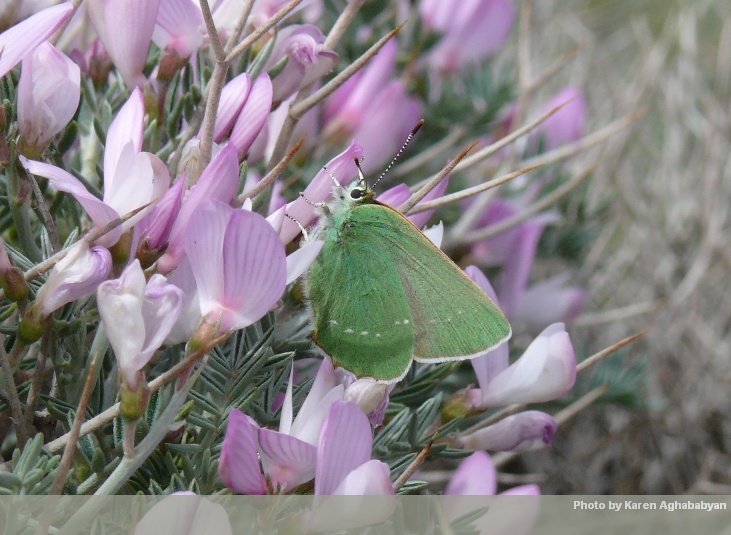
AUA ACE Introduces Sustainable Habitat & Species Conservation Mechanisms to Armenia
3 min readYEREVAN, Armenia – Butterflies are a significant and essential component of global terrestrial ecosystems such as forests, tundras, and grasslands. They comprise about 1% of all known species on the planet and provide essential ecosystem services such as pollination for many plants and food for many species, including birds and amphibians. There are 576 species inhabiting Europe (Warren & van Swaay 2006), while Armenia—the size of Belgium—hosts 220 butterfly species.
This high degree of species diversity is explained by the geo-climatic position of Armenia and its wide variety of habitats. The country ranges in elevation from less than 400 meters to more than 4000 meters above sea level and houses semi-deserts, mountain steppes, alpine grasslands, deciduous forests, coniferous woodlands, rocky outcrops, and more.
The Meghri region, located in the southern part of Armenia, is one of the richest areas in the country with respect to diversity of butterfly species. “Although Meghri region comprises less than two percent of Armenia’s total area, it hosts 66 percent of Armenian butterfly species. Some of these species face the risk of extinction,” says Karen Aghababyan, chief scientist of the AUA Acopian Center for the Environment (AUA ACE).
Thirty-five species in the region are listed in the European Red Book as “species of concern” and two are included as threatened in the IUCN Red List. Metal mining, overgrazing by domestic livestock, and incorporation of new lands for agriculture are among the key threats that species and habitats face in the region. Arevik National Park in the Meghri region was established in 2010 as a response to these threats.
In October 2013, AUA ACE scientists, with assistance from the Rufford Small Grant Program, began a project called “Butterfly species and habitat conservation in selected region of Armenia” to assist Arevik National Park to manage the threats to butterfly species and habitats.
The aim of the project is to identify butterfly diversity hotspots (i.e. areas that have high rate of species diversity but are threatened) and to introduce measures that support species and habitat conservation. The main conservation measure that will be introduced through this project is called Prime Butterfly Area (PBA).
PBAs are areas selected because they are important for species that are conservation priorities. Protection and proper management of these areas will not only help to conserve these target species, but also the many other butterfly species the areas contain. PBAs as a conservation tool have been used in Europe for decades, but to date they have not been established in Armenia.
“AUA ACE scientists will cooperate closely with the administration of the Arevik National Park to identify threats and to provide necessary training on butterfly identification and monitoring methods for the Park’s staff and interested local inhabitants,” says Aghababyan. The project will also designate butterfly-watching trails. As the initiative progresses, researchers will assess the feasibility of reintroducing select species to PBAs, and plant critically needed host plants to strengthen native but damaged plant populations. This project will contribute to development of sustainable conservation measures in Armenia and in the regions.
The AUA Acopian Center for the Environment (AUA ACE) is a research center of the American University of Armenia. AUA ACE promotes the protection and restoration of the natural environment through research, education, and community outreach. AUA ACE’s focus areas include sustainable natural resource management, biodiversity and conservation, greening the built environment, clean energy and energy efficiency, as well as information technology and the environment.
Apollo (Parnassius apollo) is a globally endangered species included in Red List of International Union for Conservation of Nature that lives in subalpine meadows.
The Blue butterfly Tomares romanovi is included in Red Book of the Animals of Armenia. In Meghri region it has extremely localized distribution restricted to two populations which can easily be damaged by open pit mining.

The Hairstreak Callophris paulae is not included in any of Red Lists, nevertheless the species is vulnerable being habitat specialist and subsequently having limited distribution.


Comments are closed, but trackbacks and pingbacks are open.